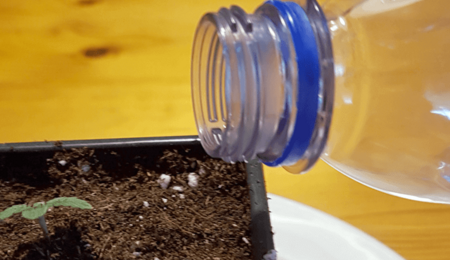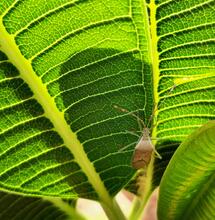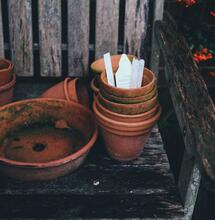Top Tips On Using Water
11 Dec 2018

By Stoney Tark
Water is essential to all life on Earth and especially when growing Cannabis plants. The overall quality of your water and frequency applied can make a big difference in the way your plants grow. Below are my top tips to consider when using water in your garden.
 When hand watering try to not oversaturate the growing medium.[/caption]
Nutrient companies can offer products that are customised to hard or soft water. It is also advantageous to know the quality of your water source before making any nutrient solution. My top tip here is to find out as much detail as you can about your local water source, or simply boil off a pan of tap water and see what residue is left behind.
When hand watering try to not oversaturate the growing medium.[/caption]
Nutrient companies can offer products that are customised to hard or soft water. It is also advantageous to know the quality of your water source before making any nutrient solution. My top tip here is to find out as much detail as you can about your local water source, or simply boil off a pan of tap water and see what residue is left behind.
 Roots need oxygen as well as water to grow healthy.[/caption]
Roots need oxygen as well as water to grow healthy.[/caption]
 This is a plant that has been fed only water the full cycle, and is responding very well.[/caption]
This is a plant that has been fed only water the full cycle, and is responding very well.[/caption]
Hard Or Soft?
Depending on where you live or where your water is sourced from, will determine if your water supply is in fact hard or soft water. The difference between the two is the amount of Calcium that is left behind as a residue. Soft water is smooth and has very little salt residue after boiling or evaporation. [caption id="attachment_8967" align="alignnone" width="800"] When hand watering try to not oversaturate the growing medium.[/caption]
Nutrient companies can offer products that are customised to hard or soft water. It is also advantageous to know the quality of your water source before making any nutrient solution. My top tip here is to find out as much detail as you can about your local water source, or simply boil off a pan of tap water and see what residue is left behind.
When hand watering try to not oversaturate the growing medium.[/caption]
Nutrient companies can offer products that are customised to hard or soft water. It is also advantageous to know the quality of your water source before making any nutrient solution. My top tip here is to find out as much detail as you can about your local water source, or simply boil off a pan of tap water and see what residue is left behind.
Water Temperature
Cold water holds more dissolved oxygen, however finding a happy medium of temperature to dissolved oxygen, should be done with the roots best interest in mind. Roots can react badly to cold temperatures, which can lead to stunted growth, unhealthy roots and a cold growing medium. I personally find warm water is the best for plants and to water thoroughly until you get drip through at the base. My top tip here is to water around the base of the pots as well as the centre will ensure the roots have an even distribution of nutrient solution, at least if feeding by hand.Good Quality Water and Bad Quality Water
To grow successfully in a hydroponic system, oxygen rich nutrient solution is provided. Especially more so with a DWC system,where the roots are actively submerged in the water. The roots of a Cannabis plant thrive off oxygen rich environments and so do beneficial bacteria and fungus that are helping the plants’ uptake of nutrients, Bad quality water will have an odour to it, that has formed over the stages of the water remaining stagnant. If you have ever smelt a drain pipe that has been left undisturbed and smelt the foul stench that smells like a mix of eggs and Sulphur. This is because the water has become a breeding ground for anaerobic bacteria that live and reproduce. My tip here is to always add an air stone to your water supply if it sits in the same place, or is not directly from the tap.Hydrogen Peroxide
The use of hydrogen peroxide when growing in hydroponic systems has many advantages. The main one is to keep pathogens and root disease at bay. Roots also absorb the oxygen allowing them to grow at a much faster rate in hydroponics. It is good to know that oxygen increases pH levels, so adding more air stones than necessary can have an adverse effect over a long period of time. My top tip here is that hydrogen peroxide will also kill any type of bacteria, good or bad so make sure that if you are suing beneficial microorganisms, you avoid hydrogen peroxide. [caption id="attachment_8968" align="alignnone" width="800"] Roots need oxygen as well as water to grow healthy.[/caption]
Roots need oxygen as well as water to grow healthy.[/caption]
pH and EC
Very important factors that will determine the quality of your water. Plants will utilize nutrients as they walk a fine line of acid and alkaline, secreting their own toxins to replace what is being used. Using a pen to perform a reading of potential hydrogen and electron conductivity will ensure your plants can absorb what they need to without needing to compensate. My top tip here is to invest well in a good brand of pen, and do not be scared to buy a space that you can keep around in case of emergencies. [caption id="attachment_8969" align="alignnone" width="800"] This is a plant that has been fed only water the full cycle, and is responding very well.[/caption]
This is a plant that has been fed only water the full cycle, and is responding very well.[/caption]



.png)